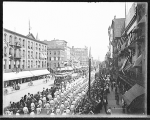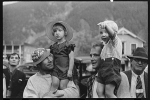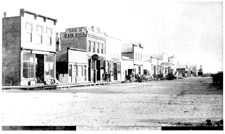Today in History: September 5
The First Labor Day

Labor Day Parade,
Main Street,
Buffalo, New York,
circa 1900.
Touring Turn-of-the-Century America, 1880-1920
On September 5, 1882, some 10,000 workers assembled in New York City to participate in America's first Labor Day parade. After marching from City Hall to Union Square, the workers and their families gathered in Reservoir Park for a picnic, concert, and speeches. This first Labor Day celebration was initiated by Peter J. McGuire, a carpenter and labor union leader who a year earlier cofounded the Federation of Organized Trades and Labor Unions, a precursor of the American Federation of Labor.
McGuire had proposed his idea for a holiday honoring American workers at a labor meeting in early 1882. New York's Central Labor Union quickly approved his proposal and began planning events for the second Tuesday in September. McGuire had suggested a September date in order to provide a break during the long stretch between Independence Day and Thanksgiving. While the first Labor Day was held on a Tuesday, the holiday was soon moved to the first Monday in September, the date we continue to honor.

Miners with Their Children, Labor Day Celebration,
Silverton, Colorado,
Russell Lee,
photographer,
1940.
FSA/OWI Photographs, 1933-1945
American Memory has over 40 photographs documenting Silverton, Colorado's 1940 Labor Day celebration. To see this mining community's parade and other festivities, search on Silverton in FSA/OWI Photographs, 1933-1945.
New York's Labor Day celebrations inspired similar events across the country. Oregon became the first state to grant legal status to the holiday in 1887; other states soon followed. In 1894, Congress passed legislation making Labor Day a national holiday.
For many decades, Labor Day was used by workers not only to celebrate their accomplishments, but also to air their grievances and discuss strategies for securing better working conditions and salaries. Nowadays, Labor Day is associated less with union activities and protest marches and more with leisure. For many, the holiday is a time for family picnics, sporting events, and summer's last hurrah.
- Read about other significant days in the history of labor. Search the Today in History Archive on labor to find features such as the history of the eight-hour workday.
- For images and documents pertaining to labor unions, search across the American Memory collections on the term labor union.
- American Memory contains hundreds of photographs of parades and processions. To view these images, search the collections of photographs and prints using the keyword parades, or the name of a specific parade.
The Outlaw Jesse James

Part of Briggs Avenue,
Park River, Dakota Territory,
circa 1880.
The Northern Great Plains, 1880-1920
The infamous Jesse James was born on September 5, 1847. At seventeen, James left his native Missouri to fight as a Confederate guerilla in the Civil War. After the war, he returned to his home state and lead one of history's most notorious outlaw gangs. With his younger brother Frank and several other ex-Confederates, including Cole Younger and his brothers, the James gang robbed their way across the Western frontier targeting banks, trains, stagecoaches, and stores from Iowa to Texas. Eluding even the Pinkerton National Detective Agency, the gang escaped with thousands of dollars.
Despite their criminal and often violent acts, James and his partners were much adored. Journalists, eager to entertain Easterners with tales of a wild West, exaggerated and romanticized the gang's heists, often casting James as a contemporary Robin Hood. While James did harass railroad executives who unjustly seized private land for the railways, modern biographers note that he did so for personal gain—his humanitarian acts were more fiction than fact.
Jesse James's outlaw days ended abruptly in 1882 when fellow gang member Robert Ford fired a bullet into the back of his head. Ford hoped to claim the $10,000 offered for James's capture but received only a fraction of the reward. He did, however, secure himself a place in Western outlaw lore which lives on in literature, song, and film.
IN LOVING MEMORY OF MY BELOVED SON, MURDERED BY A TRAITOR AND COWARD WHOSE NAME IS NOT WORTHY TO APPEAR HEREJesse James's epitaph, selected by his mother, Zerelda James
- Listen to one of many songs written about Jesse James. Search on Jesse James in these two collections of field recordings: Voices from the Dust Bowl, 1940-1941 and in The John and Ruby Lomax 1939 Southern States Recording Trip.
- View The Great Train Robbery, the 1903 film classic inspired by Western outlaws. It is just one of several hundred early films available in Inventing Entertainment: The Edison Companies.
- For personal accounts of Jesse James's activities, search on Jesse James in American Life Histories, 1936-1940. Of particular interest are the interviews with "James McGuire," who grew up with the James boys, and "L.A. Sherman," who had a memorable encounter with Jesse James in a Quincy, Illinois mess hall.